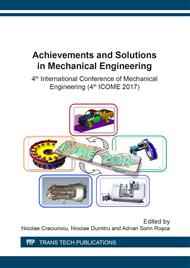[1]
S. Belmer, T. Fink, I. Lorenz and H. Neukirchner, Steuertriebe für Verbrennungsmotoren. Konzeption, Auslegung und Basiskonstruktion, MTZ Motortechnische Zeitschrift 66, No. 6, 2005, p.466–475.
DOI: 10.1007/bf03226749
Google Scholar
[2]
K. Holmberg, P. Anderson and A. Erdemir, Global energy consumption due to friction in passenger cars, Tribology International 47 (2012) 14.
DOI: 10.1016/j.triboint.2011.11.022
Google Scholar
[3]
T. Hyakutake, M. Inagaki, M. Matsuda, N. Hakamada and Y. Teramachi, Measurement of friction in timing chain, JSAE Review 22: 5 (2001).
Google Scholar
[4]
M. Schwaderlapp, F. Koch and J. Dohmen, Friction Reduction - the Engine's Mechanical Contribution to Saving Fuel, Seoul 2000 FISITA World Automotive Congress, Seoul, Korea, (2000).
Google Scholar
[5]
R. Papuc, R. Velicu and C. C. Gavrila: Geometrical study of guide-chain contact, for general chain transmission, Annals of the Oradea University, Fascicle of Management and Technological Engineering, vol. XXIII (XIII), Oradea, 2014/1, pp.123-126.
DOI: 10.15660/auofmte.2014-1.2995
Google Scholar
[6]
M. T. Lates, R. Papuc, and C. C. Gavrila: Tribological modelling of the normal forces distribution on the toothed chain links, Annals of the Oradea University, Fascicle of Management and Technological Engineering, vol. XV (XXV)/1, Oradea, 2016, pp.97-102.
DOI: 10.15660/auofmte.2016-1.3214
Google Scholar
[7]
R. Papuc, C. C. Gavrilă and M. Lates: Modeling the pressure distribution in the contact between guide and chain, Bulletin of the Transilvania University of Brasov, vol. 9 (58), no. 2, Series I - Proceedings of the IXth International Conference on Product Design, Robotics, Advanced Mechanical & Mechatronic Systems and Innovation – Prasic, Brasov, 2016, pp.197-202.
Google Scholar
[8]
J. H. Pfalzgraf: Experimentelle Reibleistungsuntersuchungen an Kettentrieben im Verbrennungsmotor, PhD thesis Technical University Munchen, (2011).
Google Scholar
[9]
M. R. Naji, and K. Marshek: Experimental determination of the roller chain load distribution, Journal of Mechanisms, Transmissions, and Automation in Design, No. 105, 1983, pp.331-338.
DOI: 10.1115/1.3267365
Google Scholar
[10]
L. Jurj, R. Velicu, R. Saulescu: Influence of profile angle on forces distribution on silent chain transmissions, Annals of the Oradea University, Fascicle of Management and Technological Engineering, Volume XXVI, (XVI) Oradea, (2017).
DOI: 10.15660/auofmte.2017-1.3282
Google Scholar
[11]
Schaeffler Group Automotive, Schaeffler Chain Drive Systems, SCDS Catalogue, 2009pp. 8-10.
Google Scholar


